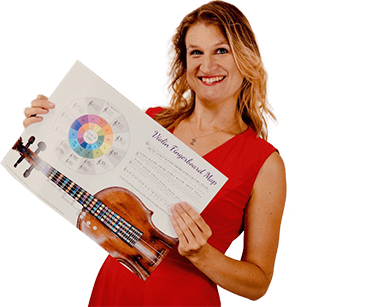Neck Stretching and Strengthening Exercises for Violinists | Violin Lounge TV #406
Do you experience tension or pain while or after playing the violin?
In this video I show you stretching exercises that relax your neck:
Warning: the stretching exercises shown in this video work for me personally. That doesn’t mean they’ll benefit you!
Listen to your body and do what feels right.
If you have serious issues with your neck or other part of your body, make sure to visit a medical professional.
My video shares my personal experience as a violinist and can in NO way replace professional treatment, advice or therapy.
Doubt if you should get help? Do it, because your body is the most valuable asset you have and your most important musical instrument!
Was this video helpful? Support my work by sharing it on Twitter:

Hi! I'm Zlata
Classical violinist helping you overcome technical struggles and play with feeling by improving your bow technique.
As I do a lot of violin practice, computer work, carrying around my video gear and of course taking care of my babies while carrying baby no 3, I’m asking quite a lot of my body.
As a violinist I do neck stretching exercises several times a day
Twice a week I do strengthening exercises as part of my work out routine.
What has helped me very much to avoid pain and stiffness from playing the violin is that I shouldn’t train the muscles I use in violin playing, but other muscles. It appeared my ‘violin muscles’ were overtaxed and overtrained, while other muscles were undertrained. In my work out I balance out my body, so I don’t overtax certain muscles.


I am an Osteopathic physician. I would offer an addition to the first exercises.
First I must emphasize the importance of passive stretching by arm pressure, not active stretching using the neck muscles in the direction of the stretch.
The modification is as follows:
Prior to the stretch, hold the neck firmly with the arm and exert very gentle neck muscle pressure in the OPPOSITE DIRECTION from the intended stretch. Do not exert enough neck muscle force to move the head against the arm pressure. This is intended to be a very mild isometric effort. Hold this stretch in the opposite direction for about ten seconds, then relax the neck pressure for about 10 seconds, then, using the arm pressure only, pull the neck into the stretch and hold as you describe in your video. Repeat this sequnce about three times in a row, or until repeating does not result in a greater stretch than the previous round.
This is a form of muscle energy manipulation which can be performed on oneself. Most muscle energy treatments require the actions of a therapist.
Thank you so much for this addition!
I should have said “pressure in the oppoiste direction”, not “stretch in the oppoiste direction” because there is no motion in the opposite direction, only pressure.
Also, the release of the stretch should be gradual, definitely not followed by a quick neck movement out of the stretch.
The exercises you demonstrate (including modification described by the commenter above) are included in a more comprehensive full body workout program called “essentrics” which I highly recommend. Currently I access it through odc.com (website for a California based dance company which has put its offerings online during the pandemic). I particularly like that they incorporate a lot of finger and wrist work (with a big emphasis on isometric work) Speaking not as a professional but as longtime adult (over 60) practitioner of figure skating and ballet, including pointe work, the tendency to tighten neck muscles or introduce tension in the shoulders is partly the result of insufficient strength and inexperience in accessing muscles in the back, arms and especially the core. It is really important that the back muscles and abdominal muscles support what you do with your arms so they have to be strong. And the feet, calves, quads, hamstrings, gluteal muscles (all three!) need to provide strong support too! It all matters. There are a lot of different opinions on whether it is better to stretch before strength work or after but my preferred order is to do a little cardio warm up, followed by stretching followed by strength work and finish with some stretches. Since the pandemic, there is no figure skating so I am doing extra strength workouts and also practicing (or playing) violin many hours a day and no pain! I do remind myself through both violining and exercise to beware of any neck or shoulder tension.
Thanks for the additional information, Jane!
Jane, I think the URL you referenced is actually: https://www.odc.dance/
Thanks!